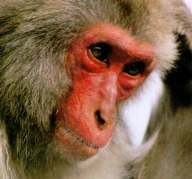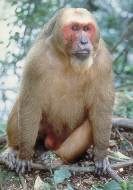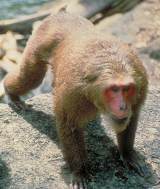9870 St Vincent Place, Glasgow, DC 45 Fr 45.
Вид: Macaca arctoides = Медвежий (краснолицый) макак

- Класс: Mammalia Linnaeus, 1758 = Млекопитающие
- Инфракласс:Eutheria, Placentalia Gill, 1872 = Плацентарные, высшие звери
- Отряд: Primates Linnaeus, 1758 = Приматы
- Семейство: Cercopithecidae Gray, 1821 = Низшие узконосые обезьяны, мартышки, мартышковые, мартышкообразные
- Род: Macaca Lacepede, 1799 = (Обыкновенные) макаки
- Вид: Macaca arctoides I.Geoffroy = Медвежий (краснолицый) макак
Вид: Macaca arctoides I.Geoffroy = Медвежий (краснолицый) макак
 КРАСНОЛИЦЫЙ МАКАК (медвежий макак), вид обезьян рода макак. Характеризуется коротким, как бы обрубленным хвостом и коренастым телосложением. Лицо его ярко окрашено, мех длинный и густой. Этот вид обитает от Ассама до Юго-Восточного Китая, часто на большой высоте, а также в областях, где бывают суровые, холодные зимы. Пища краснолицых макаков очень разнообразна. Они выкапывают сочные коренья, переворачивают камни и бревна в поисках насекомых и других мелких животных, на морских отмелях выискивают ракообразных или забегают на плантации, где поедают фрукты и листья. В зимнее время они раскапывают снег в поисках пищи. Держатся большими стадами. Самцы делятся с самками и детенышами добычей.
КРАСНОЛИЦЫЙ МАКАК (медвежий макак), вид обезьян рода макак. Характеризуется коротким, как бы обрубленным хвостом и коренастым телосложением. Лицо его ярко окрашено, мех длинный и густой. Этот вид обитает от Ассама до Юго-Восточного Китая, часто на большой высоте, а также в областях, где бывают суровые, холодные зимы. Пища краснолицых макаков очень разнообразна. Они выкапывают сочные коренья, переворачивают камни и бревна в поисках насекомых и других мелких животных, на морских отмелях выискивают ракообразных или забегают на плантации, где поедают фрукты и листья. В зимнее время они раскапывают снег в поисках пищи. Держатся большими стадами. Самцы делятся с самками и детенышами добычей.
Похож на японского красным цветом кожи лица бурый или медвежий макак, живущий в Индии, Бирме, Китае и на Индо-Китайском полуострове. Вот что рассказывает об одной особенности бурых макак известный приматолог Э. П. Фридман: "Они довольно часто охотятся на птиц, мелких млекопитающих, пресмыкающихся, моллюсков, насекомых. Добычу делят с родственниками, включая детенышей и друзей. Чем выше ранг охотника, тем менее он щедр с иждивенцами". Любопытная черта, не правда ли?

Краснолицый, или медвежий макак – лицо его ярко окрашено. Макаки полудревесные, полуназемные существа. Фрукты, листья, побеги, моллюсков, крабов – что только не приспособились есть эти обезьяны. Они часто совершают набеги на плантации риса, сахарного тростника, маиса. В Индии макаки почитаются как священные животные. Раньше часть урожая каждый крестьянин должен был сам оставить на поле в пользу обезьян.
ECOLOGY
Starting the day at dawn, stump-tailed macaques spend the early morning, until midday, traveling and feeding. They are frugivore-omnivores and a significant part of their diet is devoted to fruits. They also eat seeds, flowers, leaves, roots, freshwater crabs, frogs, birds, bird eggs, and insects (Fooden 1990; Rowe 1996; Srivastava 1999). They also raid crops prefering corn and other cultivated fruits. During the middle of the day, the group stops traveling and rests in the shade, spending time on social activities such as grooming while juveniles and adolescents play (Fooden et al. 1985). In the late afternoon foraging begins again as they travel to their sleeping site, usually large trees or cliffs. The daily range of stump-tailed macaques is between two and three kilometers (1.24 to 1.86 mi), but they do not have to travel as far during the rainy season when food is more abundant. Home range is unknown but thought to be several square kilometers (Srivastava 1999). Though they spend the majority of the day traveling on the ground, usually along the banks of rivers and streams, stump-tailed macaques also forage for fruit and leaves in trees and flee to trees when in danger (Fooden 1990).

In Mexico, stump-tailed macaques readily experiment with new foods, including native Mexican plants that would obviously not be encountered anywhere in their natural range in Asia. The Mexican stumptails hunt spiders, worms, snails, insects, frogs, lizards, birds and field mice and also search out turtle and bird eggs (Fooden 1990). Their diet is also supplemented by researchers in the form of a prefabricated pellet diet as well as assorted fruits and vegetables (Brereton 1994).
Potential predators of stump-tailed macaques include clouded leopards, leopards, dogs, and large raptors. When predatory animals are near, they respond by assuming threatening postures, shaking trees and branches, and baring their canine teeth in threat. No predation event has been recorded (Srivastava 1999; Chetry et al. 2002-2003).
